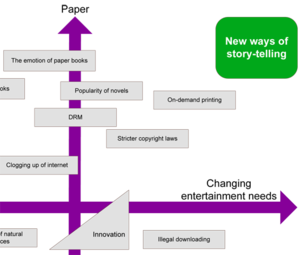New ways of story-telling
The scenario
Fast-paced society
Our entertainment needs have drastically changed in the past years. Our society has gone into the highest gear; everything is so fast paced now. Video games are the obvious choice as new prominent form of entertainment, and for a while it even looked like they were going to take over all other forms of entertainment. But this didn't happen. Computer games are usually not something you can just take with you, or pick up anywhere and quickly play in short time spans. Furthermore people sometimes don't want to be bombarded by all the audio-visual force that video-game throw at you. As an alternative to video games people surprisingly kept reading books. Books of paper even! Since people seemingly could not let go of the particular experience a paper book provides.
A new model for book
Because of the change of entertainment needs publishers saw a big drop in book sales at first. But after they came up with a whole new model to provide books sales were skyrocketing again. The publishers and writers understood that their new audience wanted quick bite-sized stories, and even some interactivity in their books. And thus came the new way of storytelling: stories became shorter and episodic content became very popular. Also books in which the reader could have a choice of how the story would roll out became very popular: here a reader would get a few options on how he wanted the characters to react and download part of the story that would allow for that response. The whole model was supported by on-demand printing. People could just download their weekly episode of their favorite book and print it themselves. The printers even received some sort of intelligence and would print the book with a storyline that would most appeal to that user, based on data mining on previous story paths taken.
The role of publishers
The role of the publisher changed somewhat with this new model too. They would now maintain subscription based websites which would have new episodic content to download every day. Furthermore the larger publishers also maintained a vast network of "vending machine like" on-demand book printers. These would use recycled paper and non-oil based ink to print environmental friendly books.
Educational literature
As for educational books the market is a bit mixed, on the one side there is the definate advantage of being able to search in electronic books, and to be able to take a large amount of books with you with no added weight. But on the other side there is the fact that it is much more pleasant to read from a paper book, and that often students don't need to take a lot of books with them and that they really don't need to search in their books because they simply work from chapter to chapter. With the added development that books van be easily printed everywhere educational books received more frequent updates and were no longer quickly outdated. Most of educational books stayed paper based although a small group of people would prefer to use them electronically.
Background information
Innovation in the story writing
Because of the increased demand for shorter stories and interactivity the model for writing entertainment got completely rewritten. First of all writers would not write long novels "in one go". Instead, novels would be written in episodes, just like with television series, and brought out on a regular bases to subscribers on websites. Furthermore some writers also opted to write their book in a "multi-branch" way. This involves putting certain "decision points" in the book at which the reader can choose between a few options on how he would like the story to continue. This ofcourse is completely different from the traditional way of writing, in which the writer writes one story: his vision of how it should all happen. But demands of society forced writers to change and many surprisingly liked this way of writing, as it allowed them to explore their own story and made them think about "what would happen if...". These books became incrediably popular and even made reading more popular than it ever was before.
On-demand printing and innovation in the distribution channel
Printing has come a long way, and in 2020 the way text is printed has completely changed. Environmental issues sparked major interest in research and development in printing techniques and companies like canon and HP started spending considerable more on their research. The result of this was a very cheap and environmental friendly way of printing. It also sparked the on-demand printing "vending machine like" machines, now found everywhere on the streets. With this development most books, both novels and education, are distributed via the internet and can then be printed by the reader themselves. The added advantage of this is that the reader can run translation services on the book before printing, to have it in their language of choice or to only print parts of the books that are interesting to him, which is especially handy for educational books or in lesser extend multi-branch novels.
Technological innovation and social factors
This scenario is based on technological innovation and social factors. People continue to read because of the experience the books is providing, but the new technologies facilitates the access to books and gives more options to entertainment.The technological innovations ensure that the environment is not harmed in any way as the printing process is environmental-friendly.
Conclusion
Books, although changed from their ancient model, still are a very big part of entertainment and educational needs, and are enjoyed by billions of people worldwide.
